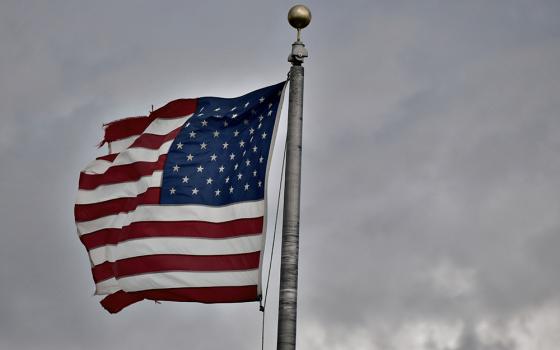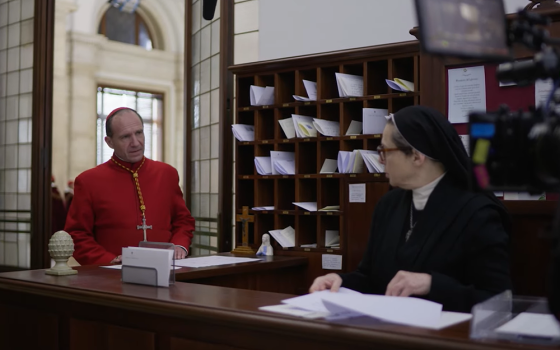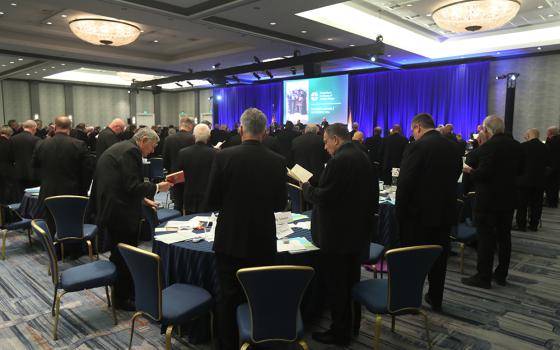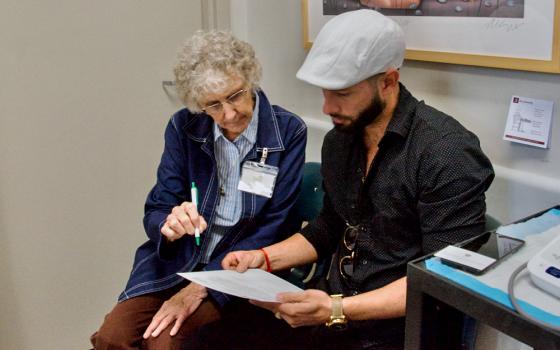
A children's Bible illustration of Exodus, Chapter 15 (Wikimedia Commons/Distant Shores Media/Sweet Publishing)
When I was a little Catholic kid, we had one of those children's Bibles. Its pages were well-thumbed by myself and my three younger brothers as we gaped at its colorful illustrations, cartoons depicting various stories from the Old and New Testaments.
Some of the pictures were bucolic, such as Noah's massive rough-hewn arc, sitting on a grassy hilltop with pairs of animals streaming toward it, dark storm clouds looming. Some were terrifying, like white-bearded Abraham pinning his son, Isaac, down on a flat rock with one hand, a gleaming knife held aloft in his other hand, in that last second before God changed his mind about that sacrifice-your-only-son-to-prove-your-faith suggestion.
We soaked in those images without question or context, which is perhaps the point of introducing stories to children with pictures instead of words.
It seems I took those tableaus quite literally. On days when the sun splayed through the clouds in fingers of light, I hid under my bed so my body wouldn't get sucked up into the sky, because a two-page spread showed us that was how people died and went to heaven. More than 50 years later, I still find I eye those cosmic Hoover rays warily.
Recently, I have been wondering if perhaps my worldview has not matured much since my picture book days.
Like most everyone on our planet, since mid-March of this year, our family has been isolated at home, hoping to keep the coronavirus pandemic from infecting us and our loved ones. This reminds me of that children's Bible page showing the creepy green fog snaking through the dusty streets of Egypt. Like the smeared lamb's blood on their front doorjambs protecting the Jews' firstborn sons from that serpentine Angel of Death, we too hope our masks and social distancing and extra hand-washing will make this current plague pass over us, and slither on by.
But that implied please-kill-somebody-else's-family-not-mine mentality seems insidious and dangerous, yes? The trouble with imagining that my particular tribe could be "chosen" to be spared allows that other tribes will neither be chosen nor saved. Like blurry figures in the background of those childhood pictures, those outside our bubbles are reduced to being muted pastel-colored huddled masses, and thus somehow less real or deserving or human. When we see the daily rising death count from COVID-19 on the news, do we really stop and remember that each digit in those statistics is a person?
This us-vs.-them idea seems to be endemic in our Bible, our church, our nation and our world. As Americans, we are clearly and intentionally polarized from the political top on down. But is blaming politics for our division from each other a bit too easy? Have we actually ever been truly one nation under God, indivisible, with liberty and justice for all?
If there is one thing I have learned from the recent protests, peaceful and otherwise, across America, the answer to that question is clearly no. The history we teach our children — in books very like our children's Bible with simple line drawings to illustrate even simpler versions of the truth — has not yet included the full picture of what has occurred in our country since its founding.
Advertisement
Our us-vs.-them mentality seems to have made sure that in general, the white majority's actions are displayed as not only heroic but patriotic. Why in our kids' textbooks did I never see pictures depicting the 1921 massacre of black people in Tulsa, Oklahoma, or what really happened when "cowboys" met "Indians," or how immigrants, especially those of color, have been happily utilized for their cheap or free labor, but at the same time vilified and dehumanized?
Our children's Bible creators certainly did not seem to shy away from showing us illustrations that were both scary and gory. Is that because biblical stories are thousands of years old, safe in our collective past, but our American stories only span the last few hundred years, and so might reflect directly onto our current culture, and us?
A month or so ago, after we were tested and found happily negative for coronavirus, we joined bubbles to form a "quaranteam" so we could provide day care for our youngest grandchild, Mary. Since she will be starting kindergarten via remote learning soon, part of each day she is here is spent reading books whose aim is not just to make her giggle (like Norman the Slug who in the process of saving Christmas also covers a bunch of gifts with slime), but to improve her skills and start her formal education.
As we flip through flash cards and peruse picture books together, I am newly and keenly reminded that her spongelike mind is taking in this information whole, not only without question but in complete and innocent trust that what I am showing her is the truth.
Mary's total faith in and reliance on me makes me reflect on Proverbs 22:6: "Train up a child in the way he should go; even when he is old, he will not depart from it." It is clearly up to me — as well as the other grownups in her life — to not only teach, but to model our behavior on what Jesus would do.
"No one is born hating another person because of the color of his skin or his background or his religion. People must learn to hate, and if they can learn to hate, they can be taught to love, for love comes more naturally to the human heart than its opposite." Nelson Mandela said this in his autobiography, written in a manuscript he was compelled to hide during his 27-year imprisonment in apartheid South Africa.
I pray that his hopeful message is indeed the truth about humanity, and that we bigger people can teach our shorter people accordingly.
The picture books I was given in my youth taught me only one side of the story. It is up to us to help our children and grandchildren look at all the pictures, in all colors and from all viewpoints, even and especially when they reveal disturbing things about those in our tribe.
In this way, Mary may be "taught to love," to learn to see people outside our bubble as individuals, not just nameless numbers on a graph or muddled lumps of color at the edges of her worldview. I hope I can remember that, too.







